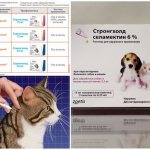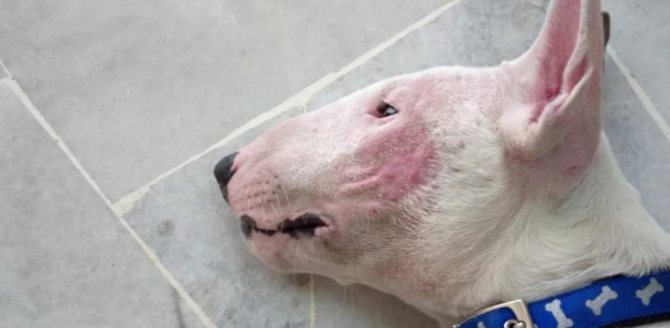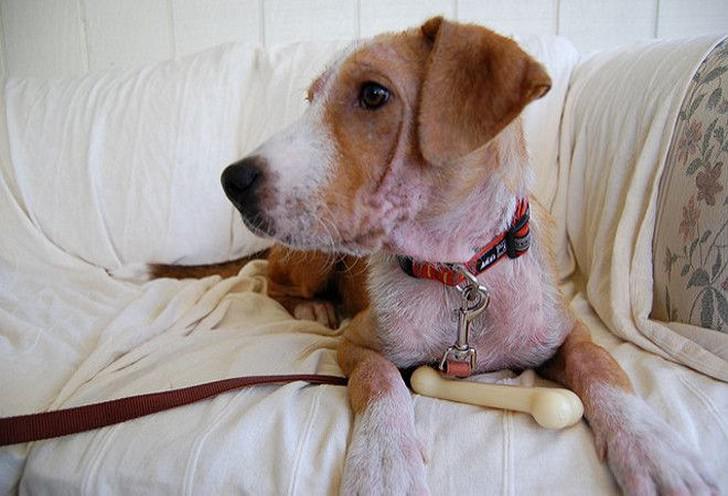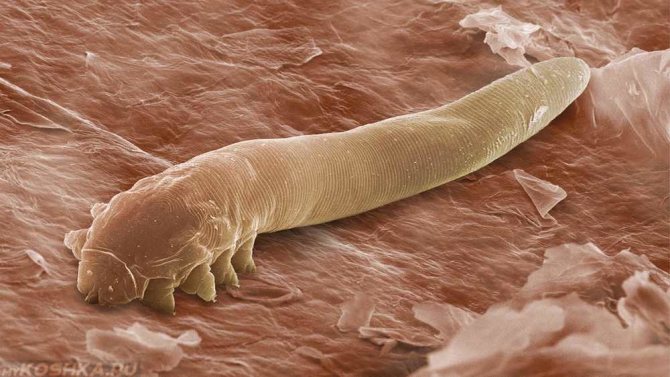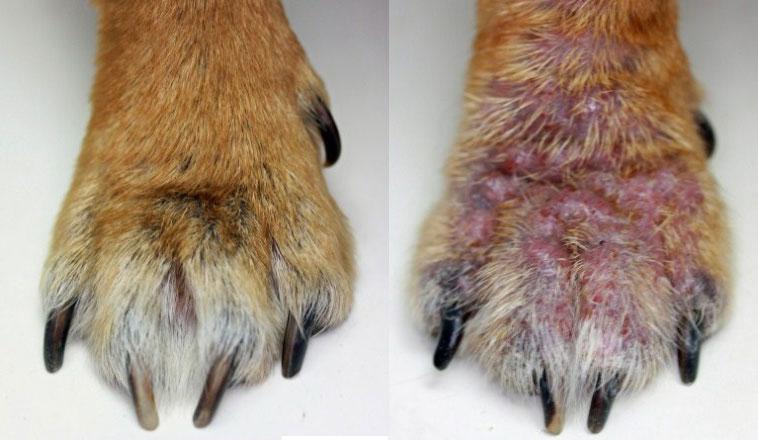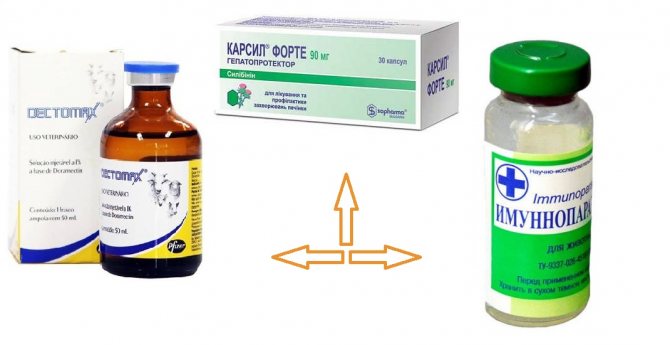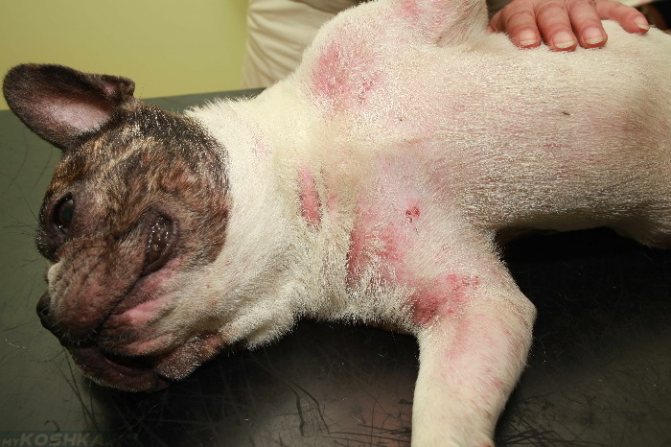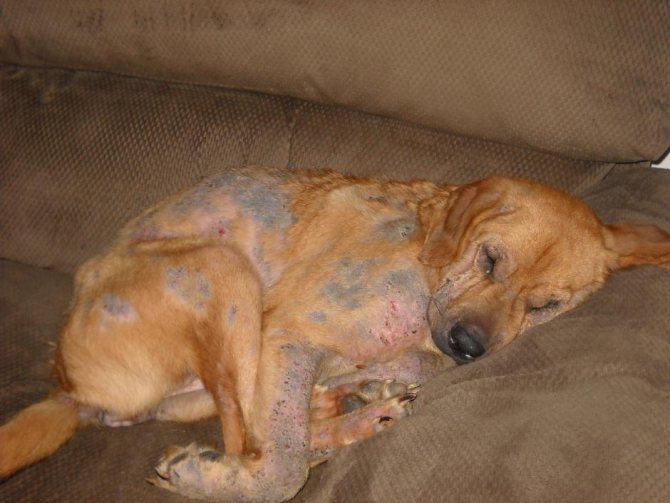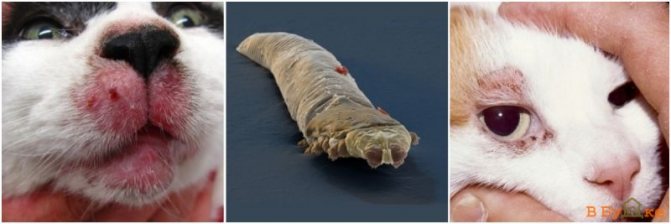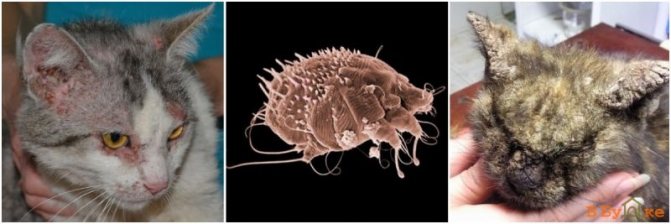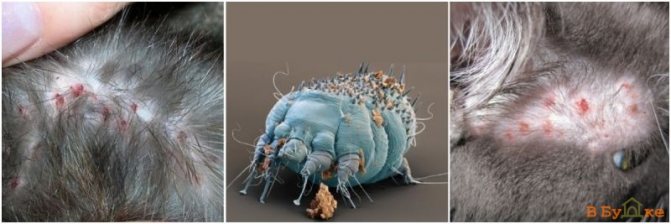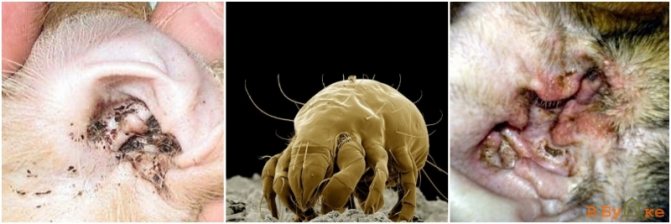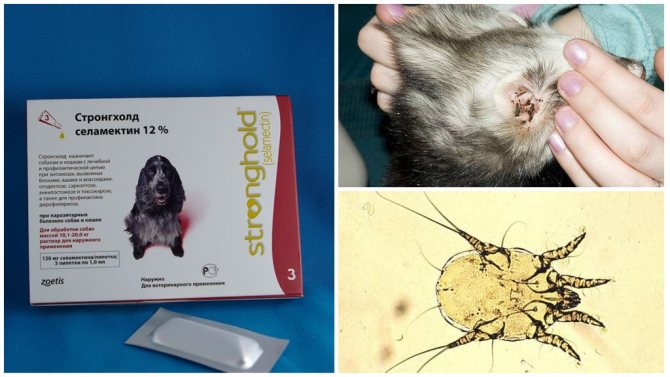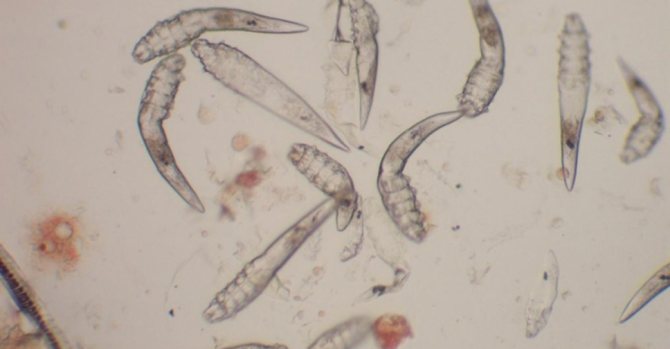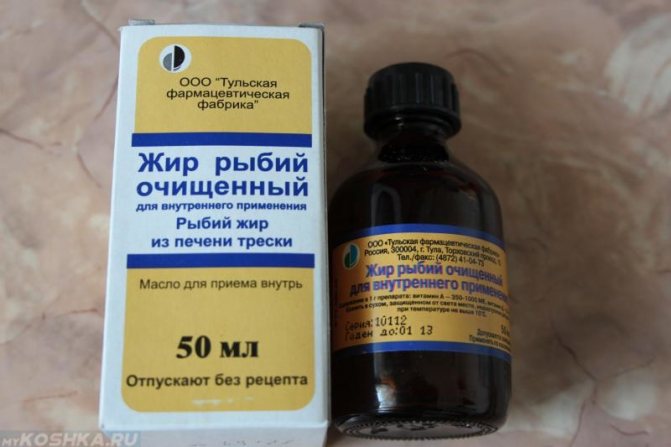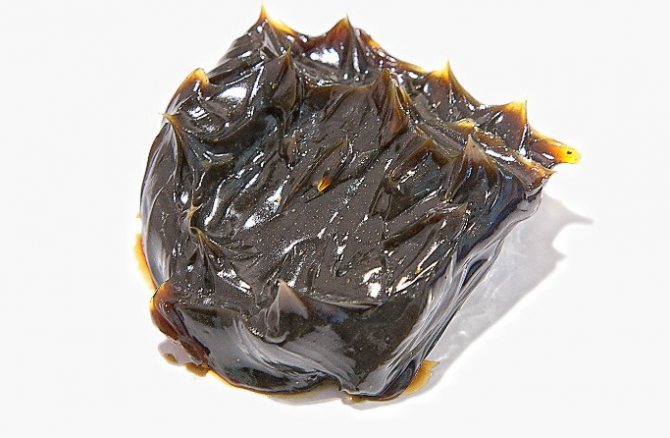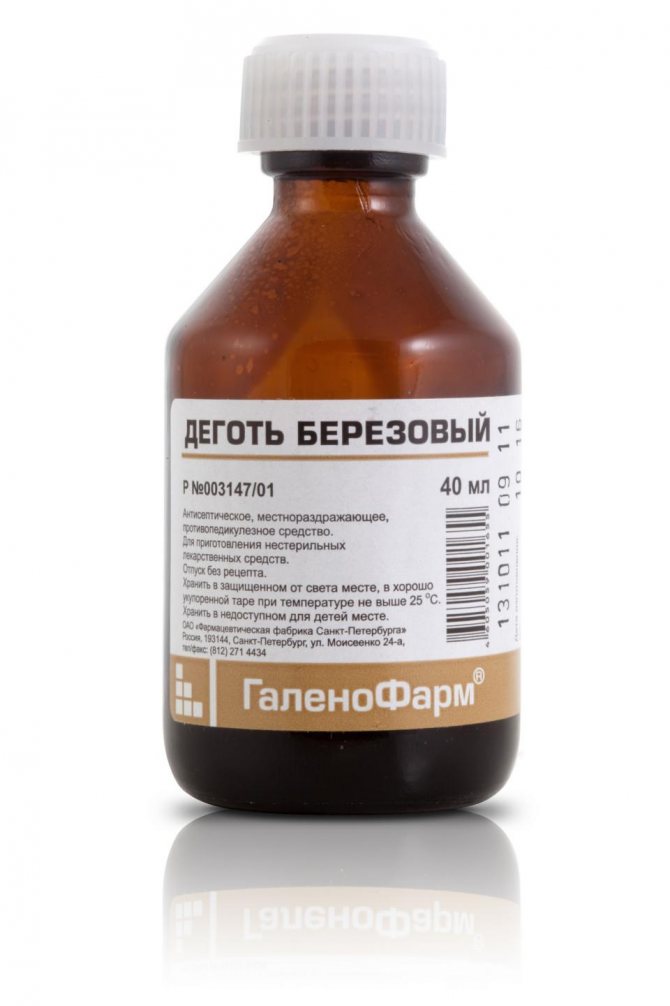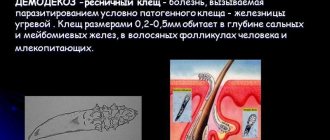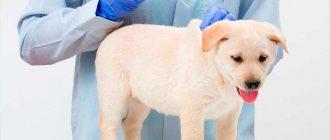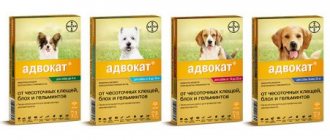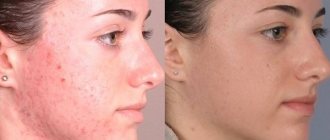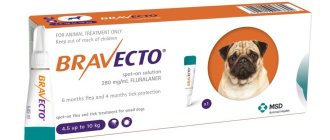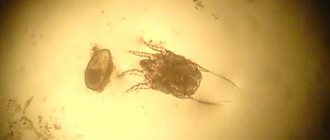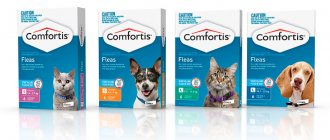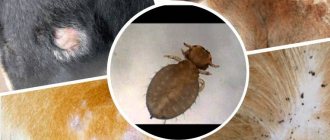Pugs have a hereditary, which is even called juvenile demodicosis of pugs. This disease is associated with the presence and reproduction of the Demodex canis mite, it harms young dogs up to 1 year old.
The disease most often develops against the background of a weakened immune system, therefore, the prevention of demodicosis is measures to strengthen the immune system. Poor feeding and housing conditions, the presence of endocrine system diseases and metabolic disorders increase the likelihood of developing demodicosis.
But it also happens that the pug gets sick with an outwardly favorable background, in this case everything is explained by a hereditary predisposition. The first signs of the disease appear in the form of local lesions on the face and forepaws. In these areas, the skin becomes red, flakes off, hair loss begins, and tuberosity appears.
Sometimes there is an unpleasant smell, as if the old house smells of mice. The pug looks like a moth-eaten fur coat. But if the infection does not begin at this stage, then everything is not so bad, and demodicosis is easy to stop. If the disease is not treated, then it progresses rapidly, and local affected areas develop into a general form of the disease.
Hair loss spreads from the head and forelimbs throughout the body, purulent inflammation begins. In the chronic form, demodicosis leads to changes in the color and structure of the skin: it becomes folded and thick, becomes gray, a huge amount of dandruff appears with an unpleasant odor.
This condition is assessed as serious and life-threatening, the situation is aggravated by the fact that the waste products of ticks enter the bloodstream, and intoxication of the body begins. With local demodicosis, the treatment consists in the destruction of the tick, with a progressive form, complex treatment is already necessary. In both cases, you need to take measures to increase immunity.
Although the symptoms of demodicosis are almost always obvious, an accurate diagnosis can only be made after taking a deep scraping from the skin. Treatment is prescribed by a veterinarian, the choice of a specific drug is determined individually, since in pugs the choice is complicated by an allergic reaction to certain drugs.
Preparations in the form of a suspension are applied to the affected areas of the skin, while this is done within two weeks after the scraping shows a negative result, that is, the tick is no longer on the skin. Also, the doctor may prescribe oral medications, special shampoos, vitamins, antibiotics. In parallel, dandruff and infection are treated.
Ear mite in a pug
Ticks can only be seen under a microscope by taking a scraping from the ear with sulfur. Earwax is an excellent breeding ground for ticks, which actively reproduce in it, laying eggs. Therefore, a good prophylactic measure is daily cleaning of the ears from wax with a cotton swab moistened with vegetable oil. Ear mite infection can occur through contact with other animals and through insufficiently clean care items.
Ear mites most commonly affect young dogs under 1 year of age.You can protect the pug with the help of careful care, measures to increase immunity, limit contact with unkempt animals and by timely treatment of the dog from fleas. The treatment is carried out for almost a month after the scraping shows a negative result for the presence of pathogens.
Subcutaneous mites
The first signs of the disease are bubbles with a clear liquid appearing on the muzzle near the nose and at the base of the ears. In these places, the hair falls out. The dog behaves restlessly and combs these areas. If treatment is not started at this stage, the disease progresses rapidly and spreads to other parts of the body, a complication arises in the form of an infection.
An accurate diagnosis is made after taking a scraping from the affected area. Treatment is carried out by the ointments and emulsions prescribed by the veterinarian, in parallel, the treatment of care items and the entire room is done, since the tick can live for several days outside the dog's body.
Forest ticks
Do not neglect preventive examinations after walking on the grass. If you see a tick sucked, coat it with iodine, alcohol or vegetable oil, pick it up with tweezers as close to the skin as possible and carefully pull it out so that the head does not remain in the dog's skin.
Did you like it? Share with your friends!
Like it! Write your comments!
How to identify the disease in a timely manner? What modern methods help to quickly cope with pathology?
A number of factors can be distinguished that contribute to the appearance of the disease:
- lack of hygienic care for animals;
- hereditary predisposition;
- general weakness of the dog associated with other diseases;
- age;
- prolonged fasting or nutritional deficiencies;
- weak immune defense;
- long-term treatment with antibiotics or other drugs that suppress the immune system.
The Demodex mite thrives best in damp conditions, therefore it reproduces well in damp rooms and on wet, irritated skin. Demodectic mange can be combined with diseases such as scabies, conjunctivitis, stomatitis and immunosuppressive conditions.
Symptoms of demodicosis in dogs
The first signs of the disease appear when ticks begin to multiply en masse. In this case, the symptoms may differ, depending on the clinical form of demodicosis.
Symptoms of the disease are divided into localized (focal), generalized and asymptomatic forms.
- Localized demodicosis in dogs is characterized by the appearance of baldness zones on certain parts of the body (more often on the head and limbs). The skin on these zones thickens, wrinkles, becomes grayish or reddish-red, covered with small scaly elements. Pustules may appear - light pink nodular rashes that darken over time and degenerate into abscesses. The pus-filled pustules burst, releasing their contents, which dries up, taking on the appearance of gray-brown scabs. The damaged skin becomes coarse and reddened, folds appear on them. In severe cases, general intoxication and exhaustion develop, as a result of which the animal may die.
- Generalized demodicosis in dogs proceeds with extensive skin lesions, with the involvement of almost all parts of the animal's body in the process. The disease penetrates into the deep layers of tissues, and internal organs are also affected. Signs of general intoxication come to the fore: weakness;
- muscle tremors and cramps;
- vomiting reflex;
- nausea (salivation);
- dyspepsia;
- the appearance of foam from the oral cavity;
- coordination disorders.
If you do not provide help to the dog in the near future, the disease can be fatal.
- Asymptomatic demodicosis proceeds without visible changes on the skin, however, with a thorough examination, Demodex mites can be detected.
Juvenile demodicosis in dogs
A special form of the disease is also distinguished, such as generalized juvenile demodicosis. This form is considered hereditary and is caused by an autosomal recessive gene. It is difficult and long to treat such a disease, in addition, after curing such dogs, they are sterilized.
Why a subcutaneous tick is dangerous for a dog
With demodicosis, the disease proceeds in a scaly or pustular form. In the first case skin reddens and cracks, and in the second - becomes moist and wrinkled due to the resulting abscesses and ulcers.
In the absence of treatment, the localized form flows into a generalized one, combining the symptoms of scaly and pustular demodicosis. This form is often complicated and difficult to treat.
If the disease spreads throughout the body, then the animal has problems with:
- stomach;
- lymph nodes;
- spleen;
- kidneys;
- liver.
Due to the resulting wounds, the dog's body becomes vulnerable to pathogenic microorganisms. A secondary infection gets into the ulcers, which is a serious danger with a weak immune system. The animal can die from sepsis.
In this regard, it is necessary to carry out diagnostics at the first warning signs that change the habitual behavior of the pet.
Complications and consequences
Demodectic mange in dogs can be complicated by other dermatologic conditions, such as rosacea, dermatitis, or conjunctivitis.
In the generalized form, damage to the stomach, duodenum, intestines, gallbladder can be observed. In addition, diseases of the endocrine system often occur, and foci of chronic infection occur.
With a weak immune system and poor-quality or inadequate treatment, the disease can result in general damage to the body and death.
Symptoms
Demodectic mange in dogs whose symptoms appear from the time when the animal has a huge number of ticks, up to 200 pieces can come to one follicle, namely:
- Inflammatory ear diseases.
- There are black crusts in the ear canal.
- Itchy ears.
- Loss of hair around the ear.
- In the focus of the disease, the skin is denser and coarser.
- When stroking the dog, hair loss occurs.
- Cellulite
- Furunculosis.
- Purulent diseases of the veins.
Diagnosis of demodicosis in dogs
Demodectic mange in dogs is usually easy to diagnose. For the correct diagnosis, the following information is taken into account:
- the result of deep scraping from the skin;
- analysis of heredity;
- clinical symptoms of the disease.
Scraping for demodicosis in dogs is carried out after squeezing the skin, so that the maximum number of ticks come out. After that, the scraping is taken as deeply as possible until a drop of blood appears. During the study, the appearance of a tick in the material in healthy dogs is not excluded. However, in a sick animal, ticks are found far from being the only number, moreover, in conjunction with eggs and immature individuals. If there is a single insect in the material, it sometimes makes sense to scrap it in another place, again.
In advanced cases, as well as in dogs with specific skin integuments (for example, a Shar Pei), histological analyzes of a biopsy specimen are often performed, a material that is obtained by a biopsy method.
, , , ,
Dosage
Stronghold can be used from the 7th week of the animal's life. The dosage is calculated based on the weight of the animal. Here you have to remember about the percentage in the solution:
- 6% = 60 mg / ml;
- 12% = 120 mg / ml.
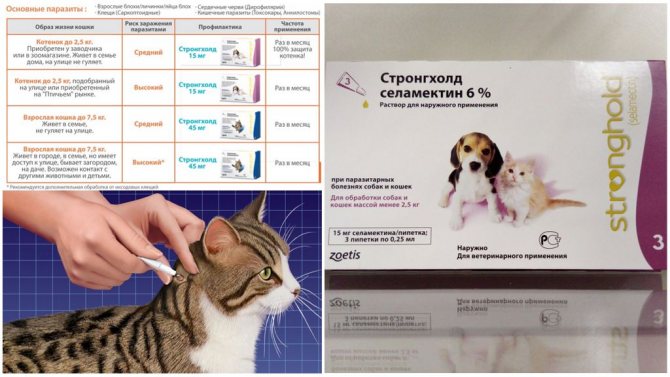
Stronghold drops for cats and dogs
It will be difficult to calculate the dosage on your own, since 6 mg of selamectin is required per 1 kg of live weight.The manufacturer packs the drug into pipettes with a gradation by animal weight:
- up to 2.5 kg - 15 mg;
- 2.6-5 kg - 30 mg;
- 5-10 kg - 60 mg;
- 10-20 kg - 120 mg;
- 20-40 kg –240 mg.
Treatment of demodicosis in dogs
The treatment regimen for demodicosis in dogs is prescribed depending on the extent of the lesion of the animal. With a localized course, spontaneous healing is possible, and with a generalized course, such an outcome is impossible.
First of all, attention is paid to competent care, hygiene and living conditions of the animal. A sick dog should be kept in a warm, dry environment with proper nutrition, which we will discuss later. If the general state of health is unsatisfactory, then it will be quite difficult to cure demodicosis.
Antibiotics and other pills for demodicosis for dogs are prescribed only by a veterinarian. Such drugs should act in several ways:
Do not use Milbemycin to treat puppies under 14 days old and weighing less than 500 g, as well as in pregnant and weakened animals.
- Bravecto is an insectoacaricidal drug. It is prescribed before meals at the rate of 25-56 mg / kg of dog's weight. The tablet is given as a whole, without crushing or breaking. It is permissible to take this veterinary drug for pregnant and lactating animals.
Penicillin therapy or sulfa drugs are also used to treat and prevent purulent infection.
Treatment with hormonal (in particular, corticosteroid) agents is contraindicated, since such drugs contribute to the aggravation of demodicosis and accelerate its transformation into a purulent form.
Lawyer
Advocate is a veterinary drug for demodicosis in the form of a solution for external use, intended for the treatment and prevention of nematoses, entomoses, sarcoptoidosis (including sarcoptic mange and otodectosis) and subcutaneous ticks in dogs.
The lawyer is prescribed for the treatment and prevention of disease, otodectosis, sarcoptic mange, entomoses, intestinal nematodes (toxocariasis, toxascariasis, uncinariosis, hookworm disease), as well as for the prevention of dirofilariasis.
The drug is applied by drip ("spot-on") application to dry, intact skin. Before use, remove the protective cap from the pipette and, placing it vertically, pierce the protective membrane of the pipette tip (putting on the cap from the back side), then remove the cap again. The drug, having parted the fur, is applied to the animal in places inaccessible for licking, directly on the skin between the shoulder blades at the base of the neck. When processing large animals, the contents of the pipettes are applied to the skin in 3-4 places. The minimum therapeutic dose for dogs is 0.1 ml / kg of animal weight (10 mg / kg imidacloprid and 2.5 mg / kg moxidectin).
Ivermek
With a subcutaneous tick, sarcoptic mange and notoedrosis, the drug is applied in a thin layer to the affected areas previously cleaned of scabs and crusts at the rate of 0.2 - 0.3 ml per 1 kg of animal weight, rubbing slightly from the periphery to the center with the capture of 1 - 2 cm of borderline healthy skin. To prevent the drug from licking off, the animals are muzzled (or the jaws are closed with a loop of braid), which is removed 15 to 20 minutes after the drug is applied. The treatment is carried out 2 - 4 times with an interval of 5 - 7 days until the animal's clinical recovery, which is confirmed by two negative results of acarological research. Animals with extensive lesions are treated in two doses with an interval of one day, applying the drug to the affected areas first of one and then the other half of the body. This is the treatment of demodicosis.
Aversectin
Usually does not cause side effects. In no case should you take the drug if you are hypersensitive to the main components of the medication. This is a serious remedy that requires special consultation before use.The therapeutic effect of the treatment of demodicosis in this way is achieved in a short time.
Vitamins for demodicosis in dogs
The expediency of using vitamins for demodicosis in dogs is controversial: some experts prescribe vitamin preparations to all animals, without exception, while others are categorically opposed, believing that such agents favor the development of ticks. Meanwhile, vitamins definitely help to strengthen the dog's immunity, which increases the body's resistance to infection.
Among the most common vitamin preparations prescribed for demodicosis, the following can be distinguished:
- "Vetzim" is a vitamin tablet preparation based on brewer's yeast. Contains vitamins of group B and E. "Vetzim" has practically no contraindications and can be used for a long time. Usually prescribed from 2 to 4 tablets per day for a month.
- Midivet is a modern adaptogen preparation containing a large amount of essential amino acids, fatty acids, macro- and microelements. Midivet accelerates the elimination of toxins, inhibits the growth of bacteria and viruses, activates skin regeneration, strengthens the immune defense, and improves liver function. The drug is used at 1-4 drops per 1 kg of body weight for 10 days. After 1 month, the treatment can be repeated.
Before giving your dog vitamin preparations, be sure to make sure that the animal is not allergic to the components of the selected product.
Alternative treatment
The most effective folk remedy against demodicosis is birch tar. It is evenly distributed over the affected skin and left for 3 hours.
In addition, you can prepare various ointments at home:
- a mixture of pure turpentine with drying oil or animal fat in a 1: 2 ratio;
- 1 part celandine juice with 4 parts petroleum jelly;
- powdered sulfur with melted fat (1: 2);
- a mixture of equal parts melted fat, grated green soap, powdered sulfur and birch tar;
- a mixture of dried chopped herb celandine with heavy cream;
- a mixture of equal parts of ground bay leaf and animal fat;
- five parts mustard oil and 1 part minced garlic;
- one part of ground elecampane root, two parts of birch tar and 4 parts of ghee;
- two parts of melted fat, the same amount of grated laundry soap, one part of powdered sulfur and one part of birch tar.
Also, wounds can be washed with infusions of such plants as buckthorn bark, elecampane root, bark grass, smoke grass.
Nutrition of a dog with demodicosis
Treatment of the disease caused by the Demodex mite should be comprehensive. Therefore, it is necessary to take into account such an important factor as nutrition. The dog should eat full, natural and fresh food, free of chemicals - flavor enhancers, dyes, etc. It is better if the food consists of meat products (boiled), as well as eggs, dairy products, vegetables, cereals.
- limiting the communication of the dog with other sick animals, as well as with stray dogs;
- compliance with the rules of dog hygiene, timely washing and combing;
- prevention of uncontrolled intake of drugs, especially corticosteroid hormonal drugs;
- full fortified food;
- thorough examination of the animals before the intended mating.
Demodectic mange in dogs is a serious illness that can provoke the development of very sad consequences. This happens when the pet's health status is not given enough attention. If you follow preventive measures and visit a veterinarian in a timely manner, then the likelihood of demodicosis can be minimized.
One of the most difficult to treat skin diseases is demodicosis in dogs.At the initial stage, the ailment may not seem too dangerous: other animals and humans cannot get infected, the pet is active, the appetite persists, even the itching is not too strong. However, without treatment, the signs of demodicosis in dogs appear more and more clearly, the disease affects the internal organs and, ultimately, can lead to the death of the pet.
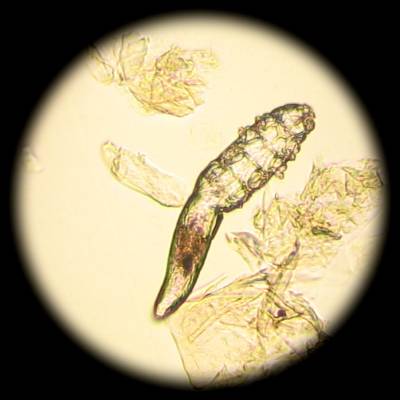

Types of worms in cats: photo, description, name and methods of struggle and treatment
- Types of worms Hookworm
- Roundworm
- Toxocars
- Cucumber tapeworm
- Wide ribbon
- Hepatic fluke
Worms are common in cats. They are infected not only by animals that go outside, but also by those who lead a domestic lifestyle. Infection occurs when a cat comes into contact with the owner's shoes or with other objects brought from the street and inseminated eggs of worms. Pet infection leads to dysfunction in the body, but it is worth remembering that these same parasites can also infect the owner.
In this article, we will look at the main types of worms in cats, which can harm not only the pet itself, but also its owner. The topic of the treatment of these parasites will also be briefly touched upon.
Types of worms
There is a wide variety of parasitic worms in nature, but the most common infections in cats are round or flat worms. Round parasites include hookworms, roundworms, toxocaras, flat - tapeworms (cucumber tapeworm, broad tapeworm, cestodes) and trematodes (liver flukes).
One type of helminthic infestation can be found in a pet, but it happens that the body is affected by two or even three types of parasites.
Most often, parasites are found when the owner notices changes in the behavior of the animal: it becomes lethargic, his appetite increases or, on the contrary, disappears, the coat looks unkempt. These are not all the symptoms of the disease, each type of parasite in its own way affects the vital activity of the animal.
Hookworm
This type of worms colonizes the intestines of the cat. The invasion occurs through the oral cavity. Larvae and sexually mature individuals feed on blood. The main signs of infection are persistent thirst, vomiting, diarrhea with bloody discharge, barking cough, lethargy and decreased appetite.
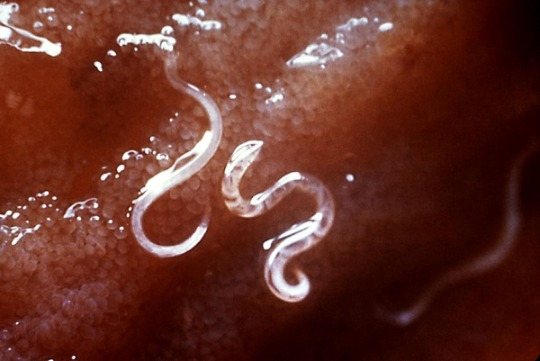

Roundworm
The most common type of infestation in cats. It is easily transmitted from animal to person if personal hygiene is not followed. These are round helminths, tapering towards the end of the tail. There are ten-centimeter individuals. Found in animal feces or vomit. The disease is manifested by chronic stool disorder, poor appetite, gagging, and decreased physical activity.
If a kitten becomes infected, then it has a characteristic appearance: tousled coat, thinness with a bloated tummy and increased appetite.
Ascaris habitat is the gastrointestinal tract, but some species can settle in the biliary tract and pancreas.


Toxocars
Some individuals of this species reach a length of fifteen centimeters. The main danger with this lesion is that the worms are able to inhabit all the internal organs of the cat, and in the absence of anthelmintic therapy, serious diseases can develop, ultimately leading to death. This disease has no characteristic symptoms, especially in the initial stage.
However, the animal still develops digestive disorders (constipation or diarrhea), weight loss, dandruff, lymph nodes may enlarge, the animal becomes more prone to allergies, which manifests itself in the form of hives, itching.
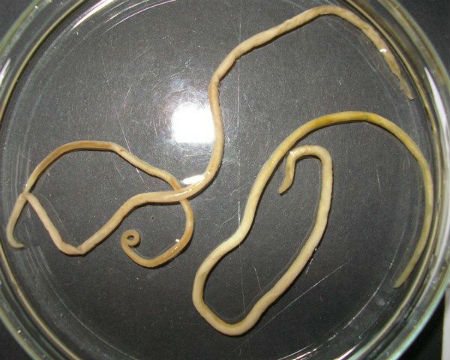

Cucumber tapeworm
It affects the intestines of a pet, attaching to the intestinal mucosa and sucking useful substances through it. Can reach thirty centimeters in length. With invasion, the animal becomes apathetic, irritable, loses weight, suffers from stool disorder, abdominal pain. A person can also become infected with this type of helminths, and the length of the parasite can reach fifty centimeters.
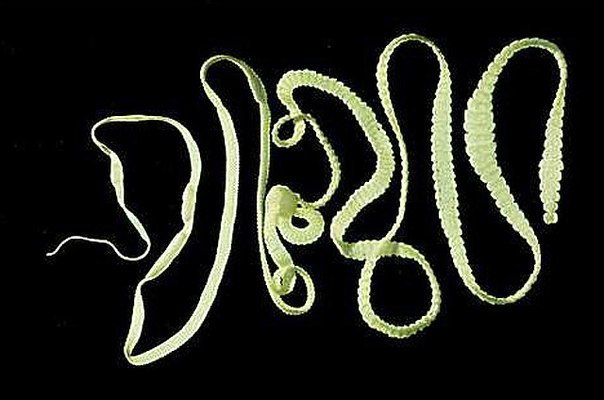

Wide ribbon
Not only cats are infected with the tapeworm, this type of helminth is found in almost all animals and humans.
Very dangerous and difficult to treat!
The place of colonization of this parasite is the small intestine. Getting into it as a larva, it attaches with the help of sharp hooks to the intestinal wall and, feeding on blood, grows in a cat's body up to two meters in size, and in a human body it can reach eleven meters.
As the parasite grows, the pet becomes more and more lethargic, apathetic, the work of the gastrointestinal tract is disrupted, and the weight decreases.
Infection routes
In recent publications, you can often read that Demodexes are part of the normal flora, that is, they live on the skin of any dog, not always causing an illness. It is noted that, like some other skin diseases in dogs, demodicosis is hereditary.
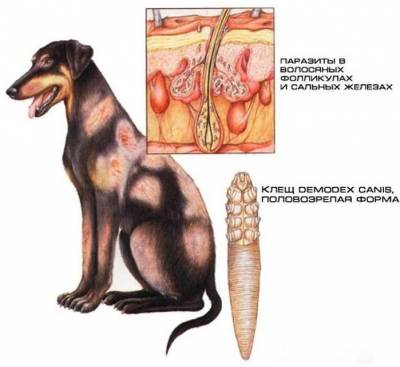

Thus, there are at least two points of view on demodicosis in dogs, the causes and routes of infection. If these ticks are not considered part of the normal flora, then contact with sick animals is dangerous (that is, a healthy dog can be infected from a sick one). If we start from another point of view, the prevention of demodicosis in dogs is reduced only to maintaining general health, since with a decrease in immunity and hormonal diseases, ticks begin to actively multiply.
What is Stronghold
The drug exists in two versions:
- Stronghold sold in Europe;
- Revolution, approved for sale in the USA.
The reason for the different names is most likely due to someone else's copyright. This is one and the same remedy based on selamectin, a drug from the avermectin group. Selamectin is structurally related to ivermectin, which is effective at killing internal and external parasites, but may not be liver safe.
Stronghold release form - drops on the withers. The drug penetrates the skin of the animal and causes neuromuscular paralysis in parasites. Stronghold is effective against worms, fleas, ear and sarcoptic mange mites.
On a note!
It is not known whether the remedy protects against ixodid ticks, since the manufacturer and advertising pass this question in silence.
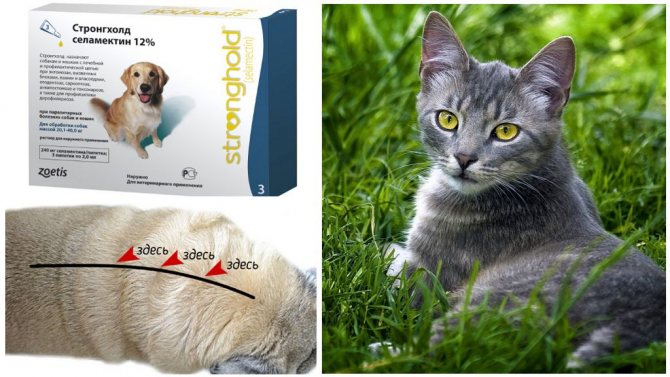

Stronghold drops for cats and dogs
Such silence looks mysterious and incomprehensible, since all drugs acting on blood-sucking insects also destroy ticks. Ear, demodectic and sarcoptic mites can be very different in appearance from ixodid mites, but all these parasites belong to the same subclass. Poisonous substances act on them in the same way. If Stronghold protects against an ear mite, it should also protect against an ixodid.
But the main emphasis in advertising is on protection from fleas and subcutaneous parasites. The protection against fleas and the method of reducing the number of these insects in the room is the same as for Nexgard tablets: the female dies before she has time to lay eggs.
Causes of the disease
The disease itself is not contagious and cannot be transmitted from dog to dog or to humans.
... Mites are transmitted at birth from the mother to the puppies and live on the surface of the skin and hair follicles. The disease depends on immunity and, as soon as it weakens, there is an impetus for its development.
The main reasons for the development of demodicosis, in addition to a decrease in immunity, also include:
- oncological diseases;
- hormonal disorders;
- the use of drugs that reduce immunity (steroids, hormones, chemotherapy).
Demodectic mange, caused by a separate disease, is commonly seen in adult dogs.In puppies under one year old, juvenile demodicosis is usually found. The reason for this is the heredity of the immune system, when the body loses its ability to control the number of ticks.
Most often, dogs suffer from this ailment in the winter-spring period.
, which is explained by a decrease in the general resistance of the animal's body.
Composition and method of application
The drug is produced in the form of 6 and 12 percent solutions. The composition of the excipients is also not indicated. And in vain, if you focus on reviews about Stronghold.
The manufacturer claims that drug intolerance in animals is rare. But buyers often complain about the symptoms of poisoning in their animals. If selamectin is excluded, then this happens in 2 cases:
- a fake was bought;
- poisoning is caused by excipients.
Stronghold does not contain oily substances and leaves no residue after use. Dries up quickly too. If any of the ethers was used as an excipient, it could cause poisoning. Also, poisoning could occur due to too much of the drug, but the manufacturer claims that even a 10-fold overdose of selamectin does not cause consequences.
Symptoms of the disease
Clinical manifestations of demodicosis begin with an unlimited increase in the number of ticks.
There are several forms of development of demodicosis.
Localized
The disease usually occurs in a dog for up to a year and does not depend on its sex and breed. They are usually physically healthy and ill due to temporary illness or severe stress.
The first signs of a localized form: sparse hair around the mouth, eyelids and on the forelegs
... The prognosis for a full recovery is favorable. Almost all sick - 90% of dogs - will recover, and in the rest of the sick, the localized form will turn into generalized.
Generalized
The generalized form is a continuation of the untreated localized form. The younger the animal, the higher its chances of a speedy recovery.
Most animals recover on their own due to the body's own defenses.
... Recovery usually occurs between 8 months and 3 years of age, depending on the breed of the dog.
The prognosis for recovery in adult dogs is less optimistic. Usually, the cause of the disease in older age is a consequence of another disease or immunosuppressive therapy. The provoking factors include: oncology, endocrine diseases, steroid treatment, metabolic disorders. The prognosis in this case depends on the underlying disease.
Juvenile
The disease occurs in puppies up to 1 year old and is hereditary. These dogs are usually spayed. If the immune system is weak, it will be very difficult to get rid of the disease. In the opposite case, the dogs independently heal from the disease.
The main symptom of the disease is formation in the form of "glasses" around the eyes or in the area of the extremities
... Dogs such skin lesions do not cause suffering, more worried about their owners. In some cases, juvenile demodicosis turns into other forms of the disease.
The causative agent is mites of the genus Demodex, which cause inflammation of the outer ear. In dogs, the disease is part of a generalized process.
Symptoms include: the presence of black crusts (exudate) in the ear canal, itching in the ear, hair loss around the auricle.
Demodectic paws
Demodectic paws most often suffer from American and. The main symptoms include: hair loss, furunculosis, erythema, cellulitis, purulent phlebitis of the veins of the extremities. Usually all 4 limbs of the dog are involved.
Photo of symptoms (Don't look impressionable)
Demodectic paws
Pathogenesis and forms of the disease
The pathogenesis of the disease has not been fully understood by veterinarians to date.An individual predisposition to the disease associated with the structure of the hair follicle was found.
There are several forms of demodicosis: juvenile, focal, generalized, pododemodecosis, otodemodecosis.
Another predisposing factor is the suppression of immunological reactions in the skin and the presence of hormonal disorders. Dogs in this case become susceptible to contact with sexually mature forms of the tick. The spread of a tick throughout the dog's body can also occur under the influence of oxytocin, which is produced in lactating bitches.
Reference.
The most susceptible to demodicosis are German shepherds, Rottweilers, boxers, Staffordshire terriers, dachshunds, Dobermans,.
The disease takes several forms:
One of the forms of the disease is otodemodecosis, in which the ears of the dog are affected.
- Juvenile. It manifests itself in puppies up to 12 months after infection from a sick mother. The reason for the development of the disease is the weak immunity of the animal. Treatment of juvenile demodicosis begins after the puppy grows up. In most cases, the disease is eliminated independently or under the influence of local remedies.
- Focal. During illness, several spots with flaky skin and falling hair appear in a chaotic manner on the dog's chest, head or paws. In 90% of cases, focal demodicosis is cured on its own under the influence of the body's defenses.
- Generalized. The spots, gradually increasing in size, cover the entire body of the dog. The skin becomes gray or red, thickens, begins to smell unpleasant from the developing inflammation.
- Pododemodecosis. Demodectic paws, which most often suffer from English and. Hair falls out on the paws, boils, purulent phlebitis are formed.
- Otodemodecosis. The outer ear becomes inflamed. Black crusts form in the ear, itching begins.
How to treat demodicosis
First aid for illness - lubrication of the affected areas with fish oil and monitoring the cleanliness of the litter
... Food should be enriched with vitamin A (for example, by adding grated carrots to the diet).
The animal should be delivered as soon as possible to the veterinary hospital for medical assistance.
The treatment regimen for demodicosis depends on the type of disease.
- When localized
the form must be monitored so that it does not develop into generalized. After the examination, the doctor will recommend the owner to bathe the dog with an antibacterial shampoo and apply a special lotion to the sore skin. It will also be necessary to periodically take a series of tests (scrapings) to monitor the development of the disease. Usually they are handed over 2 times for 2-3 weeks. - When generalized
form, the dog will need to be sterilized so as not to spread the disease further by inheritance. Treatment is reduced to the elimination of secondary bacterial infections and the elimination of all mites on the skin of the animal. External agents (ivermectin, milbemycin) are used, which are added to the water and bathed the dog. Prescribe medications depending on the breed of the animal. - When otodemodecosis
most prescribe the use of 20% Amitraz, diluted in a ratio of 1: 9 together with mineral oil. Apply the product daily.
At the same time, check if there is. Helminthiasis is an unpleasant disease that many dog breeders face.
Drugs for the treatment of the disease
As a local treatment, various preparations are used, consisting of equal parts of diesel oil and carbon tetrachloride, turpentine. An effective remedy is the subcutaneous or intravenous administration of 1% trypancin solution. At the same time, a powder of sedimentary sulfur is rubbed into the infected areas of the skin.
In the treatment of demodicosis in dogs, 2% CK-9 emulsion, 1% coral emulsion, 2% chlorophos solution, 5% soap emulsion, 1% sevin emulsion are also used. At the same time, the animal is given chlorophos orally at the rate of 25 mg per 1 kg of animal weight.
Be sure to adhere to all the recommendations of the veterinarian, then the likelihood of side effects will be minimized. Do not self-medicate your pet!
In the case of the appointment of dipping the animal, for the best penetration of the drug, it may be necessary to fix the animal in a stationary position. Bathing with medicinal products should be regular
.
Side effects can include itching, tremors, or other reactions. It is best if all manipulations are performed in a veterinary clinic under the guidance of a doctor. In addition, a soft X-ray treatment is recommended.
At home, a course of antibacterial agents is prescribed, which will take several weeks (4-10) to get rid of a secondary bacterial infection. The dog will also be given pills (milbemycin, ivermectin) to eliminate the ticks. Usually the course of treatment takes at least 3 months.
.
In the event that the dog is a collie or Australian Shepherd, drugs such as ivermectin should not be given, as they are life-threatening and have serious side effects (convulsions, coma, death).
In dogs of other breeds, side effects occur much less frequently and are not pronounced (dizziness, weakness of the hind legs, difficulty walking, stumbling).
Treatment methods
Demodectic mange is a complex disease, so it is best to treat a dog under the strict supervision of a veterinarian. When the first symptoms are detected, drugs are prescribed to destroy the tick (drops, ointment) along with general therapy for restoring immunity, removing toxins from the body, and treating the skin. If the disease is started and the specialist diagnoses the generalized form of demodicosis, then several directions of therapy are used at once. Namely: antimicrobial and antifungal, antitoxic, immunomodulatory and immunoprotective, treatment or maintenance of internal organs (liver, kidneys, heart).
Treatment of demodicosis is always complex, in addition to the drug from the tick, an immunostimulant is used and, if necessary, means to combat the secondary microflora. With strictly localized single foci in young dogs, many veterinarians do not use treatment, since the disease will go away on its own when the immune system is strengthened.
As for the destruction of the tick itself, the therapy is carried out in two ways and is associated with the form of the disease. Against adults, special ointments are used, for example, Aversectin Ointment, as well as complex preparations such as Bravecto. If the ticks are near the blood vessels, then the treatment is carried out using the drugs Ivermectin and Doramectin. When treating the skin, a special analysis of bacterial culture is required first, the type of microbes and their sensitivity to antibiotics are determined. Then, based on the analysis, a drug or ointment is prescribed.
We suggest you learn more about all the features of the Bravecto drug from the video of the webinar about demodicosis. What is the effectiveness of Bravecto, a representative of the manufacturer's company will tell (video from Uralbiovet-Consulting).
Folk remedies
As for the treatment with folk remedies, they are applicable only for the scaly form of demodicosis. So, for example, decoctions of St. John's wort, wormwood, ointment based on celandine give a positive result. To kill mites, you can find tips for using tar soap and any acaricidal products available. For the early recovery of the skin from folk remedies, you can use milk thistle oil, flax and vitamin E. Gamavit is also applicable at home (not as a remedy for demodicosis, it is more of an immunostimulating drug), Bravecto, external remedies (Advocate - drops against ticks and others).
In addition to proper treatment, demodicosis requires the owner of the dog to correct nutrition, regulate stress and improve the general conditions of keeping at home.To maintain the gastrointestinal tract during the treatment of demodicosis, probiotics and prebiotics are prescribed, as well as hepatoprotectors and general courses of vitamin and mineral supplements.
Prevention of demodicosis
Preventive measures are to prohibit contact of the dog with stray stray individuals. It is recommended to periodically conduct a thorough examination of your pet for the possible presence of skin diseases, so that if the same demodicosis is found, try to cure it as soon as possible.
It is recommended to carefully care for the hair and skin of the pet, to use special shampoos for dogs. It is not allowed to take medications for prophylaxis and treatment recommended for other breeds of animals.
Household items of a sick animal should be sprayed with 0.1% sevin solution or 1% chlorophos solution. All places where the sick dog was, is treated with a hot 5% emulsion of creolin or lysol, or disinfected by fire treatment.
At the onset of the disease, severe itching appears, the dog itches for several hours in a row. Then redness becomes visible at the base of the hair. A few days later, at the site of redness, bubbles appear with the contents, first of a brick, and then of a clay color. Within 3 - 4 days, hair falls out at the site of the lesion, the bubbles burst, releasing the fetid contents. This is how the pustular, or pustular form of demodicosis manifests itself. If there are less than five spots of hair loss, it is said to be a local lesion. If 5 or more spots are visible on the dog's body, a generalized form is diagnosed.
Dry scales are often found on the body, sticking together the wool. The scales can resemble sun-burnt dirt, bran, or fish scales. After a few days, the scales fall off along with the dog's coat. Pus is visible under them.
In severe cases, the dog is depressed, refuses to feed. Body temperature can drop to 37 degrees.
Demodectic mange in dogs - causes and course
Demodectic mites in urban environments persist on stray animals.
It is believed that for each species of animals there is a specific causative agent of demodicosis. However, in dogs with demodicosis, not only "their" ticks, but also a feline and even a human one, have been isolated. Contrary to the prejudices of doctors, the causative agent of "canine" demodicosis in humans is not found. The disease is transmitted in the habitat of stray animals. The causative agent is very mobile; You can bring a tick to a domestic dog by stepping on a sick animal's fur.
The disease occurs against the background of a weakened immune system. The protective properties of the skin are influenced by maintenance, feeding, stress on the animal and care. Changes in content, such as transferring a dog who lived on the street to an apartment, causes a change in the work of the sebaceous glands and reduces the elasticity of the skin. The reverse translation, that is, the dog who lived indoors on the street, stimulates the skin glands. The top layer of the skin loses its protective properties. Feeding and loading are closely related. Under heavy loads, the dog's body lacks nutrients and energy to maintain immunity. Small loads and abundant feeding force the body to store nutrients in the subcutaneous (loose) fiber. With the growth of fiber, the immune system ceases to control the skin. In addition, the natural processes of self-cleansing of the skin are disrupted. Scales of dead epithelium and the secretion of the sebaceous glands accumulate in the wool.
At the onset of the disease, severe itching appears, the dog itches for several hours in a row
Once on the coat, the pathogen quickly moves to the skin. It bites into the thickness and moves to the place of nutrition - the sebaceous gland near the hair follicle. The tick eats first the secret, and then the gland itself. The movement of Demodex and the excrement secreted by the mite causes severe itching. The gnawed passageway slowly fills with intercellular fluid, an excellent breeding ground for bacteria.And the pathogen moves to the next gland. Along the way, the female lays about a thousand eggs at a time, of which larvae will hatch in a week. About a month after laying the eggs, a new generation of sexually mature mites appears. The causative agents of demodicosis usually live in colonies of 2-5 thousand individuals.
A few days after the ticks enter the skin, microbes begin to multiply in the gnawed passages, causing purulent skin lesions (pyoderma). A significant proportion of these microbes normally live on the dog's skin.
Demodectic mange in dogs can last for years. Without qualified assistance, the animal dies from exhaustion and (or) blood poisoning.
Video "Veterinarian Says"
In this video you will hear an opinion on the treatment and features of demodicosis in dogs from a specialist in a modern veterinary clinic (video from Veterinary Clinic Svoy Doctor).
Pugs have a hereditary, which is even called juvenile demodicosis of pugs. This disease is associated with the presence and reproduction of the Demodex canis mite, it harms young dogs up to 1 year old.
The disease most often develops against the background of a weakened immune system, therefore, the prevention of demodicosis is measures to strengthen the immune system. Poor feeding and housing conditions, the presence of endocrine system diseases and metabolic disorders increase the likelihood of developing demodicosis.
But it also happens that the pug gets sick with an outwardly favorable background, in this case everything is explained by a hereditary predisposition. The first signs of the disease appear in the form of local lesions on the face and forepaws. In these areas, the skin becomes red, flakes off, hair loss begins, and tuberosity appears.
Sometimes there is an unpleasant smell, as if the old house smells of mice. The pug looks like a moth-eaten fur coat. But if the infection does not begin at this stage, then everything is not so bad, and demodicosis is easy to stop. If the disease is not treated, then it progresses rapidly, and local affected areas develop into a general form of the disease.
Hair loss spreads from the head and forelimbs throughout the body, purulent inflammation begins. In the chronic form, demodicosis leads to changes in the color and structure of the skin: it becomes folded and thick, becomes gray, a huge amount of dandruff appears with an unpleasant odor.
This condition is assessed as serious and life-threatening, the situation is aggravated by the fact that the waste products of ticks enter the bloodstream, and intoxication of the body begins. With local demodicosis, the treatment consists in the destruction of the tick, with a progressive form, complex treatment is already necessary. In both cases, you need to take measures to increase immunity.
Although the symptoms of demodicosis are almost always obvious, an accurate diagnosis can only be made after taking a deep scraping from the skin. Treatment is prescribed by a veterinarian, the choice of a specific drug is determined individually, since in pugs the choice is complicated by an allergic reaction to certain drugs.
Preparations in the form of a suspension are applied to the affected areas of the skin, while this is done within two weeks after the scraping shows a negative result, that is, the tick is no longer on the skin. Also, the doctor may prescribe oral medications, special shampoos, vitamins, antibiotics. In parallel, dandruff and infection are treated.
Ear mite in a pug
Ticks can only be seen under a microscope by taking a scraping from the ear with sulfur. Earwax is an excellent breeding ground for ticks, which actively reproduce in it, laying eggs. Therefore, a good prophylactic measure is daily cleaning of the ears from wax with a cotton swab moistened with vegetable oil.Ear mite infection can occur through contact with other animals and through insufficiently clean care items.
Ear mites most commonly affect young dogs under 1 year of age. You can protect the pug with the help of careful care, measures to increase immunity, limit contact with unkempt animals and by timely treatment of the dog from fleas. The treatment is carried out for almost a month after the scraping shows a negative result for the presence of pathogens.
Subcutaneous mites
The first signs of the disease are bubbles with a clear liquid appearing on the muzzle near the nose and at the base of the ears. In these places, the hair falls out. The dog behaves restlessly and combs these areas. If treatment is not started at this stage, the disease progresses rapidly and spreads to other parts of the body, a complication arises in the form of an infection.
An accurate diagnosis is made after taking a scraping from the affected area. Treatment is carried out by the ointments and emulsions prescribed by the veterinarian, in parallel, the treatment of care items and the entire room is done, since the tick can live for several days outside the dog's body.
How can a pet get infected?


According to doctors' research, Demodex Canis is present in the skin fauna of pets. Because of this, with an analysis such as skin scraping, it is often detected in healthy dogs.
The mite can be on the skin all the time, without leading to illness and unpleasant symptoms. But due to certain factors, the tick wakes up from hibernation. Reproduction of parasites begins, as a result demodectic mange develops.
The appearance of pathology is influenced by:
- Age affiliation. Basically, young animals under one year old and elderly individuals who are more than ten years old suffer from the disease. In puppies, the immune system is fragile; in elderly dogs, it is weakened.
- Hereditary predisposition. Often the pathology is transmitted to the offspring from the mother.
- Season. Usually, the disease develops in pets from mid-spring to early fall. Heat is beneficial for the growth of mites. At this time, the cycle of their development is halved. Instead of a month, the parasite becomes an adult in a couple of weeks. The female lays eggs in the thousands during this period, which complicates therapy.
- Stressful situations. If a pet is constantly exposed to nervous tension, this negatively affects its health and state of mind. All internal systems suffer - endocrine and cardiovascular, gastrointestinal tract. Due to weakened immunity, the body does not resist the influence of external factors poorly. For this reason, any interaction with the virus leads to pathology.
- Unbalanced diet. There are violations in the liver and gastrointestinal tract. This causes skin diseases (dermatosis, psoriasis). On the skin, foci of baldness are formed, where mites and fungi remain. A poorly formulated diet weakens the body and the immune system.
- Decreased immunity. This is the main reason for the appearance of pathology. The immune system is weakened due to many factors - infection with worms, interaction with sick animals, stressful situations, prolonged use of drugs.
- Insufficient care. If the rules of hygiene are neglected, deworming is not carried out on time, vaccinations are not given, they are poorly fed, they are allowed to walk on their own and come into contact with stray animals, then the risk of infection remains at a high level.
- Interaction with sick pets. In the case when the immune system is weakened, any contact with a sick animal will cause illness.
Demodectic mange is contagious to other dogs. Tick transmission occurs when touched by zoo zones. Then the pathology is noticeable in those areas with which they often come into contact. These are the front limbs, muzzle, chest, ears.
The main difference in pathology is that a healthy dog with a strong immune system may not become infected when interacting with a sick animal.If the immune system is weak and there is damage to the skin, the likelihood is high.

